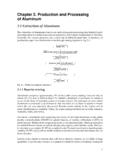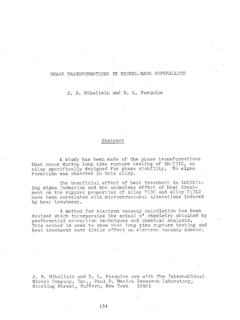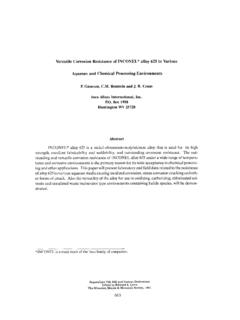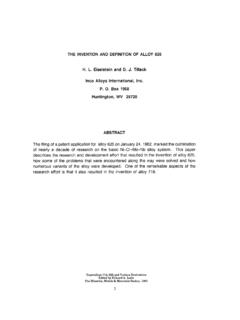Transcription of Undercooling Related Casting Defects in Single …
1 Undercooling Related Casting Defects IN Single CRYSTAL TURBINE BLADES M. Meyer ter Vehn, D. Dedecke, U. Paul* and Sahm GieBerei-Institut, RWTH Aachen, Intzestr. 5, 52056 Aachen, Germany * now at: Siemens KWU, Wiesenstr. 35,45473 MtilheimlRuhr, Germany Abstract During the Single crystal solidification of turbine blades Casting Defects such as stray grains are often formed in the inner and outer shroud due to a curvature of the liquidus iso- therm and a resulting thermal Undercooling of the melt. An intensive study of the thermal conditions in typical shroud regions for two different blade geometries was carried out using macroscopic solidification modeling and temperature measurements during Casting experiments. It was tried to reduce Undercooling Related Defects by temporarily changing the withdrawal velocity of the mold and by positively influ- encing the heat flux with ceramic insulation. In addition to that the application of grain continuators was investigated in order to eliminate stray grains while Casting large blades for use in stationary turbines.
2 Introduction Avoiding structural inhomogeneities during Single crystal solidification has always been a major point of interest to the investment Casting engineer involved with the production of high temperature components, such as Single crystal turbine blades. In order to use the full potential of these components it is necessary to optimize the Bridgman process for a result- ing defect-free as-cast structure and for better results during the subsequent heat treatment. Casting Defects can be caused by a macroscopic curvature of the liquidus isotherm while it is passing through extreme en- largements in the cross-section of the component ( transi- tion from the blade to the outer shroud) [l]. A concave shaped liquidus isotherm can result in isolated, thermally un- dercooled regions of melt. Depending on the number of nuclei in the melt and the extent of thermal Undercooling this may lead to heterogeneous nucleation close to or at the cera- mic mold and the formation of spurious grains, Figure la.
3 If a high angle boundary is formed the Casting will not be ac- cepted [Z]. If nucleation is suppressed secondary dendrites will grow rapidly lateral towards the far corners of the shroud as soon as the primary dendrites reach the transition from blade to shroud resulting in a fine dendritic microstructure in this region, Figure lb. This rapidly solidified structure is believed to have a slightly increased tendency to recrystallize during heat treatment because of its distorted lattice (mosaic struc- ture) [ 11. A convex shaped liquidus isotherm may hinder suf- ficient feeding and therefore cause open interdendritic micro- porosity on the upper side of the shroud. Superalloys 1996 It has often been recognized that thermal Undercooling in the shroud of a turbine blade causes changes in the conditions for dendritic growth [3]. This paper concentrates on macroscopic Undercooling phenomena during Single crystal solidification of turbine blades, in particular on the effect of blade geometry and of changes in the process parameters on the resulting microstructure.]
4 Tliq TllCj Figure 1: Depending on the Undercooling capacity of the given alloy a macroscopic concave curvature of the liquidus isotherm can cause the formation of stray grains (a) or result in fast lateral growth of secondary dendrites (b). Experimental procedure Macroscopic solidification modeling was used to detect criti- cal component areas that are crucial with regard to maintain- ing the Single crystal dendrite structure during solidification and heat treatment. Temperature measurements during solidi- fication with thermocouples in these regions enabled a reconstruction of the liquidus isotherm. Metallographic in- spection of macro- and microstructure was used to analyze type and extent of Casting Defects . Correlation of the metal- lographic results with the simulated and measured course of the liquidus isotherm gave information about the origin of Casting Defects . Mlted by I<. D. Kissmger, D. J. Deye, D.
5 L Anton, A. D Cetel, M. V. Nathal, T M. Pollock, and D. A. Woodford The Minerals, Metals &Materials Society, 1996 471 Two different blade geometries were investigated. The first, which was approximately 18 cm high, resembled a typical airfoil for use in aerospace engines, Figure 2. It had a simple ceramic core, and was cast in a 4 blade cluster with the Ni- base superalloy CMSX-6. The second geometry, which was approximately 30 cm high, was designed to give generally valid information about the solidification of large turbine blades for land-based turbines, Figure 3. It has an inner shroud only and was cast solid and tip down as a Single blade with the alloy SC 16. Alloy compositions of CMSX-6 and SC 16 as well as other alloy data are given in Table I. outer shroud / 0 4 \ i inner shroud P core ~: airfoil Figure 2: The small dummy blade has an inner and an outer shroud. The blade around the core has a thickness of about mm.
6 Four blades were assembled around a central runner rod in a cluster and thermocouples were placed in the outer shrouds. Table I: Nominal compositions ( ), densities and ap- proximate liquidus temperatures for CMSX-6 and SC 16. Cr co MO Ta Al 2: C N 0 CMSX-6 SC 16 10ppm 9ppm - - Ni bal. bal. density p (g/cm3) liquidus temp. ( C) 1337 1338 l- inner shroud h adapter helix 3 Figure 3: Casting set-up of the large dummy turbine blade. Macroscopic solidification modeling of the small blade was carried out with the finite element code CASTS (Computer Aided Solidification Technologies) [4], which has been de- veloped at the GieBer&nstitut and ACCESS (Aachen enter for Solidification in Space). The digital description of furnace and blade including shell mold as well as the subsequent FE mesh generation were performed with commercial software (IDEAS supertab). Due to the cluster s cyclic symmetry the mesh consists of l/ of the cluster including starter, helix, cen- tral runner and gating system.
7 It has 47,704 volume elements (tetraeders, pentaeders and hexaeders) and 3,441 surface ele- ments, Figure 4. CASTS calculates the 3D temperature distribution taking into account the release of latent heat and the heat transfer at inter- faces between different materials [5]. Because of the nature of the bridgman process natural convection was neglected. Since thermal radiation is the dominant heat transmission mechanism in the vacuum Casting process the net radiation method [6] was used to calculate heat exchange between all radiating surfaces. The transient temperature distribution and the macroscopic shape and progress of the liquidus isotherm were later visualized with the CASTS-tool COLOR3D. The SC Casting experiments were performed in a vacuum bridgman furnace (Leybold ISSIIII). A round chill plate of 15 cm diameter and a cm diameter baffle were used for the clusters of the smaller blades. The chill plate for the larger blades had the shape of a parallelogram, just like the corre- sponding baffle.
8 Al20$Si02-ceramic molds were manufac- tured by investment process. Up to 20 thermocouples per mold were positioned in and close to the shrouds of the blades. For both geometries a withdrawal velocity (v,,id) of 3 mmlmin and a heater temperature of 1550 C were standard process parameters of the Bridgman furnace. In order to reduce or even eliminate Casting Defects by smoothing the curvature of the liquidus isotherm the with- 472 Figure 4: FEM-mesh of the small dummy blade. drawal rates were varied (1 to 4 mm/min) while the solidifica- tion front was passing the critical shroud areas. In addition to that it was tried to minimize the thermal Undercooling in the shroud of the larger blades by applying insulation to the ceramic mold just below the shroud. Another means to avoid Casting Defects is the use of grain continuators [7]. A grain continuator is a simple rod (diameter: 6 mm) with which the Single crystal orientation selected by the helix is transferred from just above the helix to critical regions in the shroud.
9 Results and Discussion Small dummy blade FEM solidification modeling. For a constant withdrawal velocity (v,,,rd = 3 mm/min) the simulation shows a concave curved liquidus isotherm in the outer shroud of the small airfoil during solidification, Figure 5a. Part of the shroud on the leading edge is well below the liquidus-temperature. but since it is isolated from the solidification front in the airfoil and since the alloy has a certain capacity to undercool, it will remain liquid until secondary dendrites are able to grow into the platform or until a stray grain will nucleate due to excessive Undercooling . On the other side of the outer shroud, facing the central run- ner rod of the cluster, another large thermally undercooled zone can be identified, Figure Sb. Looking at the bottom side of the shroud it becomes distinct that this zone is connected with the undercooled volume in the overhanging shroud area at the leading edge, Figure 5c.
10 This area is difficult to access with thermocouples because of the position of the airfoil within the cluster. Therefore, only the simulation can give detailed information about the solidification sequence in this part of the component. A view onto the trailing edge of the blade shows another small isolated undercooled area in the outer shroud, Figure 5d. Temperature measurements. Temperature measurements in the outer shroud during the solidification experiments with standard parameters revealed an Undercooling of about 10 K below an approximate liquidus-temperature of 1337 C in the overhanging shroud area at the leading edge (thermocouple No. lo), Figure 6a. In another set of Casting experiments undercoolings of about 12 K were measured at the opposite side of the shroud (trailing edge, thermocouple No. 19) Figure 6b. The cooling curves of the thermocouples in the far corner at the leading edge show a small recalescence upon the sudden release of latent heat, whereas no recalescence was observed on the other side at the trailing edge.









